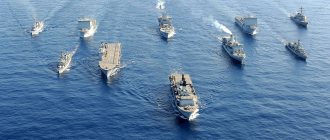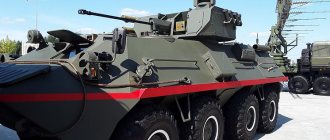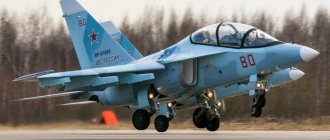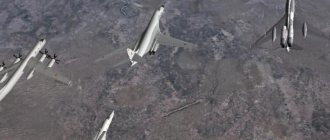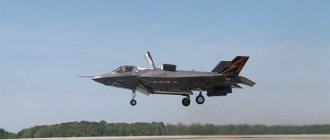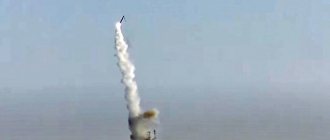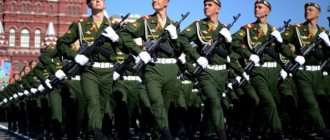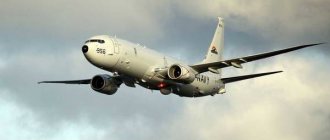Since the first use of aircraft on the battlefield, their role in military conflicts has been constantly growing. The role of aviation has become especially significant over the past thirty to fifty years. Year after year, combat aircraft receive more and more advanced electronics, more and more powerful means of combat, their speed increases, and their visibility on radar screens decreases. Currently, aviation, even alone, can play a key role in a modern regional conflict. This has never happened before in the military history of mankind.
During the aggression in Yugoslavia, NATO aviation decided the course of the conflict practically without resistance from ground forces. The same can be said about the first American company in Iraq. It was aviation that then played a decisive role in the defeat of Saddam Hussein’s large army. The US Air Force and its allies hunted Iraqi armored vehicles with impunity, having previously destroyed Iraqi combat aircraft.
There is an important nuance. Modern aircraft are so expensive (the cost of the fifth-generation American F-22 aircraft is about $350 million) that only very rich countries can afford to build or buy them. The rest can only hope for a miracle or prepare for a guerrilla war.
With the advent of new precision-guided munitions, communications systems and satellite navigation and target designation, the role and power of the air force has increased manifold. Modern and future aircraft are also changing rapidly. The use of modern materials, engines of new designs, and sophisticated electronics makes a modern combat aircraft the crown of scientific and technological progress.
Currently, leading aviation powers are creating a fifth-generation fighter. The United States already has such fighters in service - the F-22 “Raptor” and the F-35 “Lightning”. These aircraft have long passed the testing stage, were put into production and put into service. The air forces of Russia, China and Japan are still lagging behind in this regard.
At the end of the 20th century, the USSR could compete on equal terms with the United States in the skies due to the excellent fourth-generation aircraft Mig-29 and Su-27. In terms of their performance characteristics, they roughly corresponded to the American F-15, F/A-18 and F-16 aircraft. But after the collapse of the Soviet Union, the development of new cars in Russia was suspended for several years. The work was practically not funded, and new developments were often created on the initiative of the aircraft manufacturers themselves and did not find support from the state. Meanwhile, the United States wasted no time: in the 90s, the development of a fifth-generation aircraft was actively underway, and in 1997 a prototype was tested, which would later be designated the F-22 “Raptor.”
The United States is so far the only country to have a fifth-generation aircraft in service. Moreover, the F-22 is prohibited from being sold even to allies. For deliveries abroad, the Americans created another aircraft, the F-35 Lightning, but it, according to experts, has weaker characteristics than the F-22. What about Russia? What are the plans of the Russian aviation industry? Are there any promising developments that will replace fourth-generation aircraft in the future?
“Our answer to Chamberlain” - the newest military aircraft of Russia
If we look at what the Russian aviation industry can now offer to the domestic air force, we will mainly see modifications of the fourth generation Su-27 and Mig-29 aircraft. They even came up with a new classification: the Mig-35 and Su-35 are classified as generation 4++, indicating that this is almost the fifth generation. There is no doubt, both the Mig-29 and Su-27 are truly wonderful machines that were among the best in the world. But that was in the late eighties. The latest versions of these machines, of course, are seriously modified, the engines are improved, new electronics and navigation systems are installed, but will they be able to withstand the Raptor in battle?
A new generation aircraft has already been created in Russia - this is the PAK-FA (advanced aviation complex for front-line aviation), also known as the T-50. With its futuristic shape, the new Russian aircraft is very reminiscent of the F-22. The plane first took to the air in 2010, and in 2011 it was first shown to the general public at the MAKS air show. We have very little reliable information about this newest machine. The aircraft is currently being finalized, but it should go into production in the near future.
In order to try to compare the PAK-FA with its American counterpart, the F-22, you need to clearly understand what a fifth-generation aircraft is and how it differs from previous machines. The military puts forward clear requirements for the new generation vehicle. Such an aircraft must have low visibility in all wavelengths, primarily in radar and infrared, it must be multifunctional, extremely maneuverable, maintain a supersonic cruising speed (go to supersonic speed without afterburner), be able to conduct all-aspect close combat and carry out multi-channel missile fire at long range. A fifth-generation aircraft must have “advanced” electronics, which would greatly facilitate the pilot’s work.
Experts are already comparing the F-22 and PAK-FA, based on the meager information that is available today. The newest Russian aircraft has large dimensions, including a wingspan, and therefore, most likely, it will be more maneuverable than its American counterpart. The PAK-FA has a slightly higher maximum speed, but loses to the “American” in cruising speed. The Russian aircraft has a longer practical range and a lower take-off weight. However, the PAK-FA loses to the F-22 in stealth.
It is not easy to compare these two aircraft, primarily due to a lack of information. There is one more nuance: modern aircraft are not only about aerodynamics and weapons, but primarily about electronics that control all aircraft systems. The USSR has always lagged behind in this area, and the situation is similar in Russia. The Russian aircraft's radar is not inferior to the world's best analogues, but the on-board equipment leaves much to be desired.
Small-scale production of the PAK-FA began in 2014; the start of mass production of the aircraft is planned for 2020.
Here is a comparative description of the two aircraft.
| Airplane | PAK-FA | F-22 |
| Start of development | Early 80s | 1996 |
| Adopted | 2014-2015 | 2005 |
| Length, m | 22 | 18,92 |
| Wingspan, m | 14,2 | 13,56 |
| Empty weight, kg | 17500 | 19700 |
| Maximum speed, km/h | 2600 | 2410 |
| Cruising speed, km/h | 1400 | 1963 |
| Cost, million dollars | 250 | 350 |
| Stealth | Lower than the F-22 | High |
Russian military aircraft guarding peaceful skies
The Su-27 multirole fighter is designed to ensure air superiority. It appeared in service with the USSR back in the 80s and immediately became the best combat vehicle in its class. The aircraft significantly surpassed its direct competitors in speed - the American F-16 and F/A-18, has a combat radius of 750 kilometers and is capable of carrying an impressive arsenal.
Photo: W-dog.net
In addition to Russia and the CIS countries, Su-27s are still in service with China, Vietnam, Indonesia and a number of other countries in Asia and Africa. Until last year, it was on the Su-27P and Su-27UB that the Russian Knights aviation group demonstrated aerobatics.
"Russian Knights" at the Aero India 2013 air show
Video: youtube.com
Another unique aircraft of the fourth generation was the MiG-29 multirole fighter. It is designed for close combat and is highly maneuverable.
Photo: Rusarmy.com
The MiG-29 is capable of maneuvering with overloads of up to nine units and carrying missiles and bombs with a total weight of more than two tons. On these machines, aerobatic maneuvers are performed by another famous aviation group - “Swifts”. And these aircraft have been adopted by more than 30 countries.
Aerobatics of Swifts over Kubinka. As part of the Army 2015 forum
Video: youtube.com
The Su-27 and MiG-29 were the best aircraft of their time. Now they are being replaced with more advanced and modern modifications. In first place among them is the Su-35. This super-maneuverable fighter belongs to the 4++ generation. This means that in most respects it meets the requirements for 5th generation aircraft.
Photo: Mogol.info
The exception is stealth technology and the AFAR system. The former are responsible for “invisibility”, the latter make it possible to improve the operation of radars. The Su-35 is capable of detecting, tracking and attacking up to eight targets simultaneously and has already been successfully tested during the operation in Syria. Despite the fact that they have only been in operation since 2014, China has already ordered 24 vehicles from Russia and has managed to put the first of them into service.
Aerobatics Su-35C
Video: youtube.com
If the Su-35 is a modern and more advanced replacement for the Su-27, the 4++ generation light fighter MiG-35 is intended to replace the MiG-29. It is designed to fight for air superiority and deliver effective strikes against ground and surface targets from outside the enemy's air defense zone using modern high-precision weapons. Currently, the new MiGs are undergoing flight tests, and the start of operation is planned for next year. By 2022, the Russian Federation will have 20 MiG-35 aircraft in service.
Photo: Arms-expo.ru
The Su-34 multirole fighter-bomber is another successful aircraft that emerged from the Su-27. It is capable of delivering high-precision missile and bomb strikes against enemy ground targets in operational and tactical depth in conditions of strong opposition from air defense.
Photo: Oblik.msk.ru
At the same time, it can carry out combat missions without escort of covering fighters, since it is able to independently conduct maneuverable combat in the air with any modern aircraft. Su-34s were successfully used during the armed conflict in South Ossetia in 2008 and during the operation in Syria.
Destruction of an ISIS* command post by a Su-34 bomber
Video: youtube.com
Meanwhile, the era of fifth-generation aircraft is gradually dawning in the skies. And Russia has its own answer to a new round of progress - this is the Su-57. They began to be developed in 2002 and are planned to be put into mass production in 2022. Russian Su-57s have the latest on-board electronics and radar, while using modern composite materials. The exact characteristics of the aircraft are currently classified, but it is planned that they will not be inferior to their direct competitors. To date, the first stage of testing of the new machine has been completed.
Photo: Avia.pro
Tu-160 is a supersonic strategic missile-carrying bomber with a combat radius of 7,300 km. It has been in operation since the late 80s and still surpasses its American counterparts in many respects. This is the heaviest combat aircraft in the world and the fastest bomber.
Photo: Krasvozduh.ru
In 2010, he set a record for flight range in one day: 18 thousand kilometers. And in 2015, Tu-160s were involved in a military operation in Syria. They destroyed Islamic State* targets with Kh-555 and Kh-101 cruise missiles.
Launches of cruise missiles against ISIS targets in Syria from a Tu-160
Video: youtube.com
But soon the Tu-160 and Tu-95 will be replaced by a new promising long-range aviation complex. The development of this machine began at the Tupolev Design Bureau back in 2009. The first flight is scheduled for 2022, and the start of operation in 2025. The new generation strategic bomber will be capable of using all existing and future types of weapons, have low visibility and carry on board the latest communications and electronic warfare systems.
Photo: Defense.ru
*Extremist organization banned in Russia
Alexander Sablin
Flight of the Berkut
Another very interesting machine created at the Sukhoi Design Bureau is the Su-47. It's a pity that it still remains at the prototype stage. This aircraft has a forward-swept wing, which provides the aircraft with unprecedented maneuverability and rate of climb. The Su-47 made extensive use of composite materials, and the control interface in the cockpit was significantly improved.
The Su-47 was also created as a prototype of a fifth-generation aircraft. But it does not yet live up to the requirements put forward for such machines. The Berkut cannot fly at supersonic speeds without afterburner. In the future, they plan to equip the aircraft with a new engine with variable thrust vectoring, which would allow the Su-47 to overcome the supersonic barrier without afterburner.
The Berkut made its first flight in 1997; only one such aircraft was built. It is currently being used as a test site.
Here are the characteristics of the Su-47 Berkut aircraft.
| Wingspan, m | 16.70 |
| Aircraft length, m | 22.60 |
| Aircraft height, m | 6.40 |
| Wing area, m2 | 56.00 |
| Weight, kg | |
| normal takeoff | 25670 |
| maximum takeoff | 34000 |
| engine's type | 2 TRDDF D-30F6 |
| Maximum speed, km/h | |
| near the ground | 1400 (M=1.12) |
| on high | 2200 (M=2.1) |
| Practical range, km | 3300 |
| Practical ceiling, m | 18000 |
In the United States, the “crazy quirks” of the Russian Su-34 were revealed
The Russian multirole supersonic fighter-bomber Su-34 has no analogues in the world, being “one of the most intriguing combat aircraft in the world with a unique appearance.” The “crazy quirks” of the Russian fighter-bomber were revealed in the American publication The Drive.
According to the publication, the key feature of the Su-34 is its flattened front part, nicknamed “Duckling,” equipped with a Sh141 radar station, behind which there is a two-seat cockpit for the pilot and navigator-operator with K-36DM ejection seats. The publication notes that the dimensions of the cabin allow one of the crew members to stand or lie down at full height.
The sewage disposal device used by the crew, according to the publication, is a “metal canister with a cone-shaped hole at one end.” The publication notes the presence in the Su-34 cockpit of five large multifunctional liquid crystal displays, as well as one head-up display used by the pilot.
The ability to “attack ground targets day and night with high precision” is achieved by the Platan retractable optical system, which provides guidance, in particular, for KAB-1500-L bombs. The system, according to The Drive, is “suitable for some high-altitude operations, but much less useful at low altitudes.”
The tail boom of the Su-34 houses the auxiliary power unit. The publication recalls that initially it was planned to install a rear hemisphere surveillance radar in its place. The publication notes that the fighter-bomber received a chassis with a tandem wheel arrangement, allowing it to operate from “harsh airfields.”
Su-35
Another newest aircraft recently adopted by the Russian Air Force is the Su-35. In 2014, 12 such aircraft arrived at the Aerospace Forces air regiments; in total, by the end of 2022, 48 Su-35s will arrive in the Air Force. This aircraft, developed by the Sukhoi Design Bureau, belongs to the 4++ generation and has technical and combat characteristics almost at the level of a fifth-generation aircraft.
It differs from the PAK-FA only in the absence of stealth technologies and an active phased array antenna (AFAR). The aircraft is equipped with a new information and control system, phased array radar, and new engines with controlled thrust vectoring, which can reach supersonic speed without the use of afterburner. The airframe of the aircraft has also been strengthened.
With the adoption of this aircraft, Russian military pilots can fight back against the latest generation of aircraft.
Main characteristics of the Su-35 aircraft:
| Wing size, m | 14.70 |
| Aircraft length, m | 22.18 |
| Aircraft height, m | 6.35 |
| Wing area, m2 | 62.00 |
| Weight | |
| empty plane | 18400 |
| normal takeoff | 25700 |
| maximum takeoff | 34000 |
| engine's type | 2 AL-31FM turbofan engines. |
| Maximum thrust, kgf | 2 x 12800 |
| Maximum speed, km/h: | |
| near the ground | 1400 |
| at high altitude | 2440 |
| Practical ceiling, m | 18000 |
| Practical range, km: |
The main news from the world of combat aviation in 2022
Photo: kremlin.ru
2021 turned out to be extremely remarkable for various events, one way or another connected with military aviation of different countries. This applies primarily to fighters and attack UAVs.
If we talk about countries, Russia and China stood out the most in the outgoing year.
Tests of the main American novelty - the B-21 strategic bomber - were postponed (in 2022 it was reported that it could make its first flight in December of this year).
The first flight of the Russian Tu-160 bomber, assembled from scratch, was also moved to the right. Now we shouldn’t expect it until the beginning of next year.
F-15EX (USA)
On February 2, the F-15EX fighter jet, the most advanced aircraft in the F-15 family, took to the skies for the first time. In particular, it received a Raytheon AN/APG-82 radar with an active phased array antenna (AFAR), a “glass” cockpit, a system for displaying important information on a helmet-mounted display and a new flight mission control computer.
Photo: Boeing
The main feature of the F-15EX lies in its armament: the aircraft is positioned as “the most heavily armed fighter.”
It must be said that these are not empty words.
The vehicle can carry up to 22 air-to-air guided missiles, as well as a variety of air-to-surface munitions, including “hypersonic weapons up to 22 feet long and weighing up to 7,000 pounds.”
In total, the US military expects to purchase up to 200 F-15EX fighter jets.
KF-21 Boramae (South Korea)
The presentation of the KF-21 fighter was held in April at the headquarters of the South Korean aircraft manufacturing corporation Korean Aerospace Industries (KAI).
And although the KF-21 has all the hallmarks of stealth technology, it is neither stealth nor a representative of the fifth generation.
Boramae carries weapons on external mounts, which means it cannot in any way meet the requirements of stealth technology.
Because of this, the fighter is often classified as generation 4.5 or 4 plus.
In the presented configuration, the length of the aircraft is 16.9 meters and the wingspan is 11.2 meters.
It has an AFAR radar and ten hardpoints: six under the wing and four under the fuselage. The power plant is based on two General Electric F414-GE-400K engines. The crew is one person.
In the future they may create a two-seater version.
Su-75 Checkmate (Russia)
The main novelty for the Russian-speaking community, undoubtedly, was the new generation fighter Su-75, officially shown for the first time at MAKS.
The presentation was slightly spoiled by the fact that the first photos leaked to the Internet even before it began and gave a general idea of the fighter.
The aircraft is made according to a normal aerodynamic design with a V-shaped tail. The non-adjustable air intake is located under the fuselage and has an extended lower lip.
The Su-75 received one engine and has pronounced signs of stealth technology.
The weapons are placed inside, the combat load is 7,400 kilograms. On internal mounts it can carry up to five air-to-air missiles, as well as air-to-surface weapons, including ammunition such as K029BE, KAB-500, K08BE (UPAB-500B-E), KAB-250, KAB -250LG-E, Kh-38, X-59MK2, Kh-58USHK(E), Grom-E1 and Grom-E2. The vehicle does not have built-in weapons.
Usually the aircraft is positioned as an export aircraft, but as of now there is no information about a single firm order from foreign clients.
Perhaps in the future Russia itself will adopt the vehicle.
The first flight of the Su-75 is scheduled for 2023.
Double J-20 (China)
Without exaggeration, the outgoing year can be called a Chinese year.
What is the first flight of the first fifth-generation two-seat fighter in world history worth?
The car, however, was not an absolute novelty.
Firstly, it was created on the basis of the J-20, which Beijing has already produced in quantities of more than 150 units.
Secondly, information about the development of a two-seat “five” in China circulated on the Internet long before the first photographs of the fighter.
And yet this is a very significant event that could have far-reaching consequences: both for China and for the entire world aviation.
The fact is that the aircraft is being considered in the context of the potentially revolutionary concept of unmanned wingmen. It is for controlling the UAV that a second pilot can be useful.
In this regard, it is appropriate to recall that Russia also wants to get its own fifth-generation two-seat fighter. It will be built on the basis of the Su-57, and the S-70 Okhotnik is sometimes considered as an unmanned wingman.
Deck version FC-31 (China)
Like its “big brother” J-20, the Shenyang FC-31 fighter has long been no secret to anyone.
The vehicle made its first flight on October 31, 2012. Since then, the Chinese have built only a few prototypes, which has caused many to forget about the project.
At various times they talked about its possible problems, as well as the fact that they wanted to supply the aircraft to foreign customers.
The real purpose of the fighter became known in October, when a photo of the first flight of its carrier-based version, which received the unofficial designation J-35, was posted online.
Even a quick glance was enough to see the differences with the basic version.
The aircraft received a fundamentally different canopy, making it similar to the American F-35B short take-off and vertical landing fighter. At the same time, it must be assumed that China does not set itself the task of creating a VTOL aircraft.
This is supported, in particular, by the chassis design, which is very different from that of the F-35B and is more similar to what we see on the F-35C deck, designed for ejection launch.
The new product has a rod for attaching a catapult to the shuttle and a folding wing.
In other respects, the J-35 is similar to its progenitor. The vehicle has two engines, a V-shaped tail and one pilot's seat. The weapon is placed inside to maintain stealth.
New version of “Hunter” (Russia)
At the end of the year, the most ambitious Russian project in the world of UAVs made headlines.
At the Novosibirsk Aviation Plant named after V.P. Chkalov rolled out a new model of the S-70 “Okhotnik” unmanned aerial vehicle (UAV).
Photo: Rostec
“The main feature of the new Okhotnik is the flat engine nozzle. Thanks to this, the radar signature of the vehicle is reduced. In addition, a new ground control center is being created for the drone, designed with military requirements in mind. These solutions will significantly increase the machine’s capabilities,”
– Sergei Chemezov, General Director of the Rostec State Corporation, commented on the event.
Work on the “Hunter” program began in 2011. The first device, which has a “regular” round nozzle, first took to the skies in 2019.
It is noteworthy that the characteristics of the “Hunter” (we are talking about both versions of the UAV) are still not known for certain.
According to observers, it can use a wide range of air-to-surface weapons: to confirm these words, the Okhotnik dropped a bomb for the first time in December.
Still from the video “Russia-1”
The combat load is estimated at around three tons (sometimes they even talk about eight), and the take-off weight of the UAV can be approximately 25 tons.
Possible missions include reconnaissance, striking ground targets, and even air combat.
IL-112
All of the above aircraft have already left the design bureaus and factory floors and have long since made their first flight. Currently, the Ilyushin Design Bureau is developing a new light transport aircraft, the Il-112, which should replace the outdated An-26.
The first flight of the future transport aircraft is planned for 2022, and the start of its serial production is scheduled for 2020. The new vehicle will have a payload capacity of up to six tons and will be equipped with two turboprop engines. The IL-112 will be able to land and take off both from equipped runways and from unpaved airfields. In addition to the cargo modification of the aircraft, aircraft manufacturers are planning to create a passenger version of the aircraft; it can be used on regional airlines.
"Mig" fifth generation
Sergei Korotkov, general director of RSK MiG, told reporters that specialists from the design bureau are working on a fifth-generation fighter. The new vehicle will most likely be based on the Mig-35 (another Russian 4++ generation vehicle). According to the developers, the new Mig will be very different from the PAK FA and will perform completely different functions.
New strategic bomber
Russia is developing a new strategic bomber, which will replace the Tu-160 and Tu-95 aircraft. The development of the new PAK DA (advanced long-range aviation complex) was entrusted to the Tupolev Design Bureau, although it can be noted that the Tupolev team began work on this machine back in 2009. In 2014, a contract was signed between the design bureau and the Ministry of Defense to carry out design work.
There is very little information about the future aircraft, but the leadership of the Russian Air Force has stated that the aircraft will be subsonic, will be able to carry more weapons than the Tu-160 and will most likely be manufactured according to the “flying wing” design.
The first vehicle is expected to be ready in 2022, and mass production to start in 2025. It should be noted that work on creating a similar aircraft is now underway in the United States. As part of the Next Generation Bomber project, a subsonic aircraft with a low level of visibility and a long range (about nine thousand kilometers) is being developed. According to media reports, the cost of one such machine can reach half a billion dollars.
After the collapse of the USSR, the aviation industry experienced difficult times. Many projects have been delayed for years, and now is the time to catch up. The development of a sixth-generation fighter is yet to come, but for now this is almost science fiction.
Guardians of the Russian sky: how air defense aviation fights back uninvited guests at the borders
Today, January 22, those who are ready to defend their country and the security of its borders while at the controls of an airplane celebrate their professional holiday - the Day of the Air Defense Forces is celebrated in Russia. Which aircraft in Russia's arsenal are causing fear in the West - in the material of "People's News".
Air defense aviation originated in Russia since the First World War. Before its appearance, pilots had to fly out on planes and use machine guns to protect territories. Often in air combat it was necessary to use dangerous maneuvers and ram in order to shoot down an enemy plane. But such tactics were very dangerous.
In 1946, the La-9 fighter was created at the design bureau of Semyon Lavochkin, which became one of the best aircraft of its time. The La-9 was used in the USSR until 1951, and was also supplied to China and the DPRK.
wikipedia.org / Public domain
Already in the early 1950s, work began on the creation of jet fighters in the USSR. The aircraft, designed in the design bureaus of Alexander Yakovlev and Artem Mikoyan, soon entered service and began to arrive in all corners of the country.
In 1952, the MiG-17 aircraft was created in the bureau of designer Artem Mikoyan. The appearance of a new type of aircraft opened up new opportunities and prospects for the Soviet army. Thus, the MiG-17P was the first all-weather subsonic interceptor fighter of its type.
Around the same time, the Il-28 and Tu-4 bombers entered service with the USSR, which were part of the air defense forces. In the late 1960s and early 1970s, the basis of the aviation of the Soviet air defense forces was the Su-15 interceptors. The planes were part of 29 air regiments, which was enough to protect the territory. These aircraft went down in history as having made the largest number of successful interceptions of intruders entering Soviet airspace.
wikipedia.org/Public Domain
Over the years, air defense aviation units have been armed with such legendary aircraft as the MiG-1, MiG-3, Yak-1, Yak-7, Yak-9, LaGG-3, La-5, La-7. With the advent of new technologies, the aircraft fleet was replenished with more innovative models and technological developments.
Currently, pilots are armed with MiG-31 fighters. The combat aircraft reaches speeds of up to 3 thousand km and is capable of operating at an altitude of up to 21 km. The development of the next generation aircraft, the MiG-41 interceptor, is already underway.
The MiG-31 is responsible for protecting Russia’s borders; it is with the help of this aircraft that the Russian military drives away uninvited guests from the borders. This aircraft was designed to intercept and destroy enemy bombers and cruise missiles in any conditions.
flot.com / Press service of the Northern Fleet
The MiG-31 has very solid characteristics. Thus, the aircraft can reach speeds of up to 3 thousand km/h and can rise to a height of up to 21 thousand meters.
Modification of the MiG-31BM aircraft allowed the fighter to interact with air defense missile systems. Guided missiles are guided using the aircraft's radar. The fighter can be used as a command post in the air.
The unique MiG-31 is capable of not only effectively performing combat missions, but can also carry the Kinzhal hypersonic missile. The weapon is capable of hitting targets within a radius of more than 2 thousand km. The missile can overcome any missile defense in a few minutes.
Federal News Agency /
With the help of the “Dagger” you can destroy any stationary or moving object. These missiles will play a special role in the destruction of naval aircraft-carrying strike groups that have modern air defense.
An aircraft capable of carrying the Dagger was designated with the letter K. Thus, the MiG-31K has become Russia's new weapon, which is causing serious concern in the West. Many experts around the world note that the MiG-31 has unique characteristics, due to which it is still a “mysterious killer”, the lifting of which into the air “terrifies the enemy.”
Russia is currently developing a supersonic fighter-interceptor to replace the MiG-31. The new aircraft model will be called MiG-41 or PAK DP - a promising long-range interception aircraft system. Little is known about the new project; it was only said that the device would be ready to shoot down “strategic bombers, ballistic missiles and satellites.” Thus, Russia will strengthen its air defense aviation and become an impenetrable fortress that is impossible for unexpected guests to enter.
Subscribe to us on social networks ✅ VKontakte ✅ Odnoklassniki ✅ Telegram ✅ Yandex.Zen


